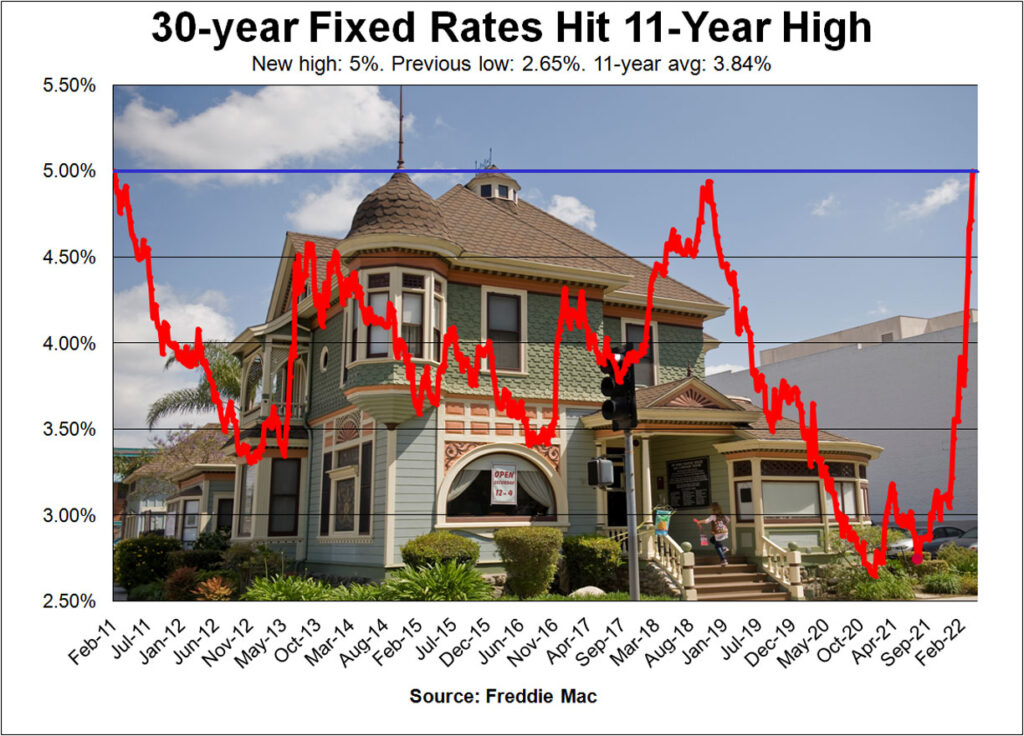
After rocketing upward for four straight months, the average rate for a 30-year, fixed mortgage hit 5% in the past week – the highest it’s been in more than a decade.
On top of that, wholesale prices surged 11.2% in March. Groceries, gasoline, and medical matters are just the tip of the overall affordability iceberg.
It doesn’t take a rocket scientist to understand these headwinds are going to make home prices reverse course.
What are pre-retirement homeowners to do? How do they maintain their overall net worth and adjust to inflationary financial pressures? Sell? What about the incredible capital gains tax one might be paying? And where to go?
Perhaps the answer for the 55 and over crowd is to tap into their home equity vault to pay lingering bills and make needed home repairs before home prices make a real swan dive.
But what kind of a mortgage is best to do that? Easy qualifying FHA reverse mortgages are a non-starter unless you are at least 62. Interest-only mortgages last at most 10 years before principal and interest payments kick in. Can you say payment shock?
A good solution for some could be an interesting mortgage hybrid that takes baby steps to a reverse mortgage.
It’s available for those age 55 and over who want to change their mortgage, do a cash-out refinance or get a new purchase loan.
The monthly cost is much lower than a regular mortgage payment or even an interest-only mortgage payment. The key difference between this and a similar mortgage product I wrote about in 2020 is the minimum age dropped to 55 from 60.
The borrower must make a partial interest payment for the first 10 years. The mortgage balance increases just like a reverse mortgage — classic negative amortization. But then, no more house payments and no more obligations to the mortgage servicer so long as you stay in your home.
If you move, refinance or pass away, the mortgage will need to be repaid.
You will always be required to maintain your home, pay your property taxes, homeowners’ insurance and any HOA fees.
Your required minimum payment — excluding taxes, insurance and HOA fees — is roughly 30% of the full payment in one illustration I reviewed. The remaining balance zoomed from $497,250 to more than $750,000 after the first ten years of payments. Again, classic negative amortization. No more payments though.
Let’s say a 55-year-old borrower takes out a mortgage and lives in the home until he or she passes at 90. Let’s assume the property is worth significantly less than what is owed on the original principal balance and the accrued interest and the property is under water.
Since this is a “nonrecourse loan,” the mortgage servicer would not be able to go after the owner’s estate to make up the difference between the home’s value and the amount owed. The heirs still will have the option to pay off the lien if they want to keep the home.
This is based upon an actuary table for the youngest borrower, who must be at least 55. The older you are, the less equity is required. Assuming the youngest borrower is 55, the down payment or equity will need to be at least 60% to make the math work, or $1.2 million on a $2 million dollar home.
Other key points include:
Borrowers must have a minimum middle FICO score of 680.
Borrowers must income qualify.
Borrowers must attend a mortgage counseling class.
The loans are available for up to $4 million
The loans are available for houses, condos and buildings with up to four units.
To refinance, borrowers must have 10 years or more remaining on their existing mortgage.
There’s no FHA mortgage insurance because this is not a Federal Housing Administration loan.
Keep in mind nothing is free.
Even though this mortgage instrument does not carry expensive FHA mortgage insurance, just like the FHA reverse mortgage, there may be enormous closing costs.
(Staff chart)
Freddie Mac rate news: The 30-year fixed rate averaged 5%, 28 whopping basis points higher than last week and the highest rate since Feb. 17, 2011. The 15-year fixed rate averaged 4.17%, 26 basis points higher than last week and the highest rate since Feb. 24, 2011.
The Mortgage Bankers Association reported a 1.3% drop in mortgage application volume from the previous week.
Bottom line: Assuming a borrower gets the average 30-year fixed rate on a conforming $647,200 loan, last year’s payment was an astronomical $731 less than this week’s payment of $3,474.
What I see: Locally, well-qualified borrowers can get the following fixed-rate mortgages without points: A 30-year FHA at 4.375%, a 15-year conventional at 4.125%, a 30-year conventional at 5%, a 15-year conventional high-balance ($647,201 to $970,800) at 4.875%, a 30-year conventional high-balance at 5.375% and a 30-year purchase jumbo at 4.625 %.
Eye catcher loan of the week: A 30-year adjustable mortgage, locked for the first five years at 3.625% with 1 point.
Jeff Lazerson is a mortgage broker. He can be reached at 949-334-2424 or jlazerson@mortgagegrader.com. His website is www.mortgagegrader.com.
Related Articles
Long-term mortgage rate reaches 5%
Nearly two-thirds of non-homeowners polled say affordability woes hinder a buy
Million-dollar homebuyers getting cheaper mortgage rates
Negative adjustable-rate mortgages are back
Mortgage rates rise 5 straight weeks to 4.72%
